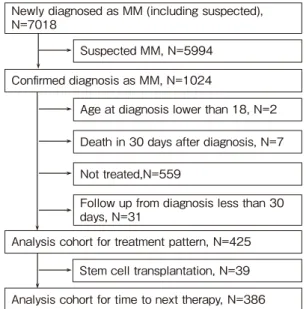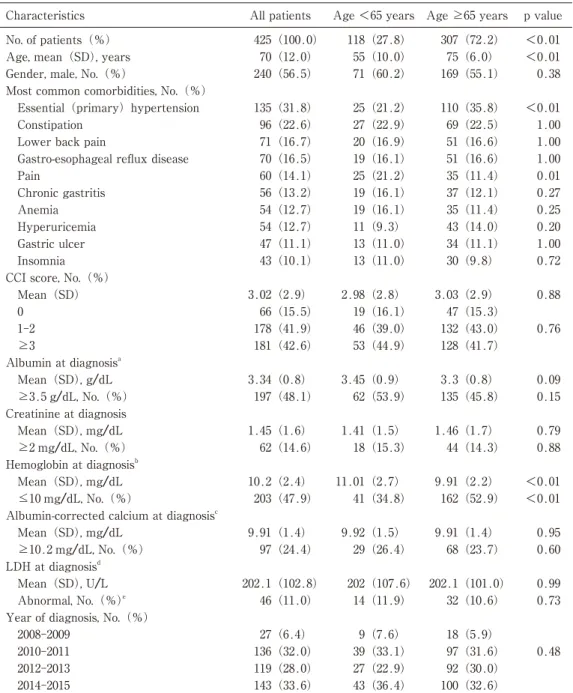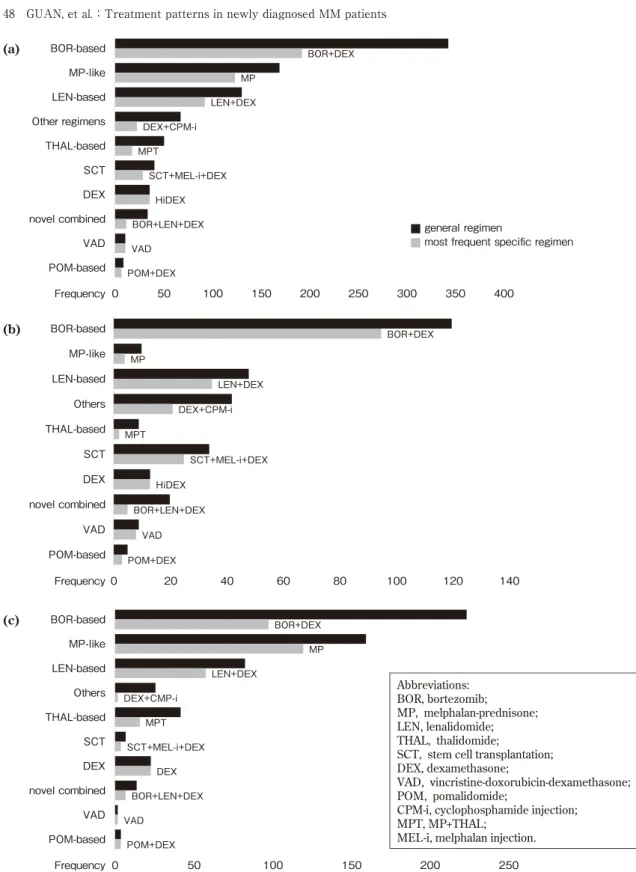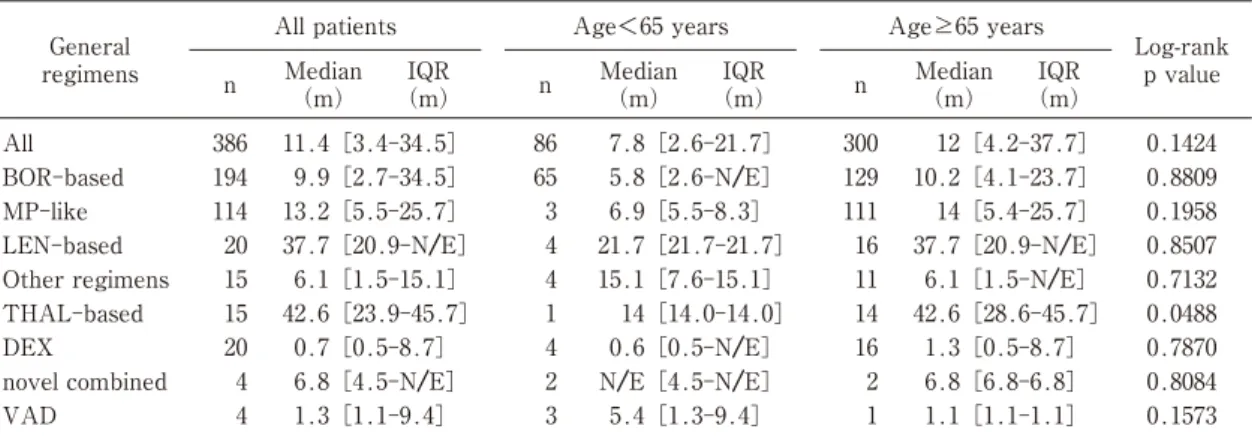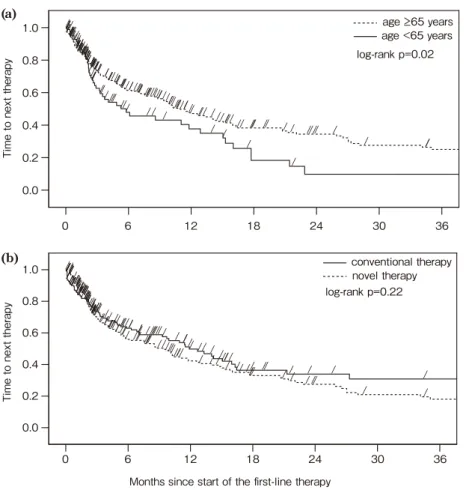Introduction
Multiple myeloma(MM)is a malignant neo-plasm caused by neo-plasma cell dyscrasia. In 2009,
the age-standardized rates of MM for males and females were 2.9 per 100,000 persons and 2.1 per 100,000 persons, respectively, in Japan, and 2.0 and 1.4 per 100,000 persons worldwide.1)
薬剤疫学 Jpn J Pharmacoepidemiol, 25(2) July 2020:43
Jia GUAN
*1*2, Shiro TANAKA
*2, Shuhei YAMADA
*3,
Izumi SATO
*1*4, Koji KAWAKAMI
*1 〈Abstract〉Objective: To describe the treatment patterns and time to next treatment(TTNT)in newly diagnosed multiple myeloma patients(MM)using a large-scale claims database in Japan.
Design: Cohort study
Methods: The patients with newly diagnosed MM from 2008 to 2015 were classified into two groups: age <65 years, and age B65 years. Specific regimens and general regimens were identified with a complex algorithm considering interval of no therapy, additional and discontinued agents. Correspondingly, TTNT between the first- and second-line were measured among non-transplant patients with Kaplan-Meier method.
Results: A total of 425 patients were eligible to participate in the analysis. The most common regimen for the treatment of MM was bortezomib-based regimens(52.9% in the first-line, 28.2% in later lines), followed by melphalan-prednisolone(27.1% in the first-line, 12.9% in later lines)and lenalidomide-based regimens(4.7% in the first-line, 26.1% in later lines). TTNT between the first- and second-line was 11.4 months and was seen to vary greatly with each regimen. A statistically longer TTNT was observed in subgroups of patients aged 65 years or over compared with patients aged younger than 65 years, but no statistical difference was found between conventional therapy and novel therapy.
Conclusion: Based on the data from the study, patients with MM were commonly treated with novel agent-based regimens, especially bortezomib-based regimens. Between the first-and second-line therapies a relatively short TTNT was observed, indicating that therapies in clinical practice poorly complied with treatment guidelines.
(Jpn J Pharmacoepidemiol 2020;25(2):43-53)
Keywords:multiple myeloma, drug therapy, administrative claims, healthcare, retrospec-tive studies, Japan
Treatment Patterns in Newly Diagnosed Multiple Myeloma
Patients in Japan Using A Large-scale Claims Database:
Retrospective Cohort Study
〇Original Article
*1
Department of Pharmacoepidemiology, Graduate School of Medicine and Public Health, Kyoto University, Kyoto, Japan *2
Department of Clinical Biostatistics, Graduate School of Medicine and Public Health, Kyoto University, Kyoto, Japan *3
Department of Quality and Patient Safety Management, Chiba Cancer Center, Chiba, Japan *4
The Keihanshin Consortium for Fostering the Next Generation of Global Leaders in Research(K-CONNEX), Kyoto, Japan.
Address for correspondence: Koji KAWAKAMI, Department of Pharmacoepidemiology, Graduate School of Medicine and Public Health, Kyoto University, Yoshida Konoe-cho, Sakyo-ku, Kyoto 606-8501, Japan Phone: +81-75-753-4459, Fax: +81-75-753-4469, E-mail: kawakami.koji.4e@kyoto-u.ac.jp
The median age of Japanese patients when diagnosed with MM was 66 years, and the incidence and mortality increased with age.1)
Over the past decade, novel agents for the treatment of MM in Japan included bortezomib (BOR, approved in 2006), thalidomide(THAL, approved in 2008), lenalidomide(LEN, approved in 2010), and pomalidomide(POM, approved in 2014), all of which have achieved a striking improvement in patient outcomes.2)−5)
More importantly, an extension in overall survival was observed in Japanese patients after the introduc-tion of novel agents.6)
NCCN and ESMO clinical practice guidelines have recommended BOR+cyclophosphamide (CPM)+dexamethasone(DEX), BOR+doxoru-bicin(DXR) +DEX, and BOR+LEN+DEX for transplant candidates, and BOR+LEN+DEX and LEN+low-dose DEX for non-transplant candidates as primary therapies. Autologous transplantation was recommended proceeding straight after induction therapy to high-dose therapy for transplant candidates.7)8)Historically, transplant was not considered as an option for patients older than 65 years, correspondingly in clinical practice, patients who received stem cell transplantation(SCT)were significantly more likely to be under 65 years as initiation therapy than those who did not.9)
In Japan, a retrospective cohort study reported that the most common regimens among re-lapsed/refractory MM patients were BOR± DEX, melphalan(MEL) +prednisolone(PSL), and LEN±DEX between 2008 and 2016.10)
MM was managed by successive each line of therapies (LT), which resulted in shorter response dura-tion over prior LT.11) However, prior studies did not address the treatment patterns and clinical outcomes among newly diagnosed MM patients in Japan. Therefore, we investigated the treat-ment patterns for MM patients with respect to age and transplantation using a large-scale claims database in Japan.
Patients and Methods
Data source
We conducted a retrospective cohort study using anonymous claims data provided by Medical Data Vision Co., Ltd.(MDV;Tokyo, Japan),12)an organization that has collected data since April 2008. The MDV database contains information for 11.66 million inpatients and outpatients(over 9% of the Japanese popula-tion)from 208 hospitals in Japan as of Septem-ber 2015. The database comprises information such as anonymized patient identifiers, age, sex, diagnosis, laboratory test, procedure, surgery, prescription, and discharge summary.
The protocol of this study was approved by the Committee of Medical Ethics, Graduate School of Medicine, Kyoto University(protocol number: R0193). Informed consent was waived since the database protects patient anonymity.
Patients
We identified patients with newly diagnosed MM(ICD-10 code, C900)aged 18 years or older between April 1, 2008 and September 30, 2015. Newly diagnosed MM was defined as 1)the first diagnosis date later than April 1, 2008 and later than the date of first medical record for the patient in MDV database, whichever came later; or 2)at least one medical record of suspected MM before diagnosis. Patients were excluded if only hospitalization records exist since from date for case of hospitalization in MDV database could not be identified as first diagnosis date. We excluded information from patients who only had a suspected diagnosis of MM, did not receive any medication for MM therapy, died within one month after diagnosis with MM, or could only be followed for less than one month. The date of initial MM diagnosis was defined as an index date and patients were followed from this date to the cause of death, completion of the study(Septem-ber 30, 2015), or until loss before the follow-up period, whichever came first.
All patients were classified into two groups according to their age and corresponding
treat-ment strategies:age <65 years(younger group�, and age B65 years(elderly group�.
Demographic characteristics were primarily measured on the index date. We measured all the diseases within one year before the index date and calculated Charlson Comorbidity Index(CCI) score13� for comorbidity evaluation. Laboratory test results were extracted within one month of the index date.
Treatment patterns
We identified the prescription of agents for MM therapy, novel agents(BOR, LEN, THAL, and POM�, and conventional agents(MEL, vincristine(VCR�, CPM, DXR, DEX and PSL�. The algorithm to determine treatment lines and specific regimens was based on three steps (Figure 1):1)A time gap without therapy for MM over 28 days was considered as start of the subsequent treatment line, but if the 2 consecu-tive regimens were the same, then they were regarded as in the same treatment line.14�2)An agent for MM therapy initially prescribed over 28 days later than the start date of previous agent was also defined as start of the sequential treatment line.15�,16�
3)Discontinuation of a single agent from a combination regimen was not considered as a change of treatment line, which may due to an adverse event or health condition.17� After identifying the crude treat-ment lines, we excluded regimens with single PSL or single low-dose DEX(<16.5 mg per day) as they are generally prescribed for other diseases. We then repeated the above algorithm to identify the final treatment lines and specific regimens.
If the sequential specific regimens contained the same main agent, we categorized them as a general regimen such as BOR-based regimens, LEN-based regimens, THAL-based regimens, POM-based regimens, and melphalan-predniso-lone(MP�-like regimens. If two or more novel agents were prescribed in a specific regimen, this was defined as a combined regimen using novel agents. With the exception of the above-mentioned general regimens, we also identified
VCR-DXR-DEX(VAD�, and DEX(B16.5 mg per day�, and�Other regimens�represented regimens that have not been mentioned above. Time to next treatment between the first- and second-line therapies
We used time to next treatment(TTNT)as the clinical outcome of the study. TTNT between the first- and second-line therapies was defined as the time from the start of initial therapy to the start of the subsequent line of therapy. The patients who accepted SCT were excluded due to the potentially short and fixed period of the induction therapy.
薬剤疫学 Jpn J Pharmacoepidemiol, 25�2� July 2020:45
Figure 1 Algorithm created to identify treatment patterns
Step 1.A time gap without therapy for MM over 28 days was considered as start of the subsequent treatment line, but if the 2 consecutive regimens were the same, then they were regarded as in the same treatment line A
B
>28 days >28 days 1st regimen:A
2nd regimen:B
Step 2.An agent for MM therapy initially prescribed over 28 days later than the start date of previous agent was also defined as start of the sequential treatment line.
<28 days >28 days A B C 1st regimen:A+B 2nd regimen:A+B+C
Step 3.Discontinuation of a single agent from a combina-tion regimen was not considered as a change of treatment line, which may due to an adverse event or health condition. >28 days A B C 1st regimen:A+B 2nd regimen:C
Legends:◀initial date of an agent
◆ subsequent prescription date MM therapy
We evaluated the differences of TTNT among subgroups by age and therapy, age <65 years versus ageB65 years, and novel regimens versus conventional regimens, respectively. During the first treatment line, patients who died, or lost follow-up, were censored at the date of last medical record.
Statistical analysis
We described the study variables including patient characteristics and treatment patterns. Continuous measurements were summarized as the mean and standard deviation or as the median and interquartile range;counts and percentages were calculated for categorical variables. TTNT was described with the Kaplan-Meier method and was compared between younger and elder patients, and patients receiv-ing novel regimens versus conventional regi-mens, with the log-rank test. A two-sided a level of 0.05 was considered statistically significant. All analyses were conducted using SAS version 9.4(SAS Institute, Cary, NC).
Results Patients
A total of 425 newly diagnosed MM patients were eligible for the analysis(Figure 2). Of these patients, 118(27.8%)were younger patients(age <65 years), and 307(72.2%)were elderly patients(ageB65 years)(Table 1). Overall, the mean age at diagnosis was 70 years;besides, the mean age per group was 55 and 75 years in the younger group and elderly group, respectively. Overall, 56.5% of patients were males and they accounted for 60.2% patients in the younger group. The most common comorbidities among patients were essential hypertension(31.8%), constipation(22.6%), and lower back pain (16.7%). The most frequent CCI score was between 1-2 points in all three groups(41.9%). Laboratory tests showed that 48.1% of patients had high albumin, 14.6% had high creatinine, 47.9% had low hemoglobin, 24.4% had high albumin-corrected calcium levels and 11% had abnormal LDH at diagnosis. Since the MDV
database collected patientsʼ data mainly from 2010, less data(6.4%)were obtained for pa-tients who were diagnosed in 2008 and 2009. Treatment patterns
The most common general regimen was the BOR-based regimen(38.4%), and BOR+DEX was the most common specific regimen. MP-like regimens were the second most commonly prescribed regimens(19.0%), followed by LEN-based regimens(14.6%), other regimens(7.6%), THAL-based regimens(5.7%), SCT(4.6%), DEX(4.0%), combined regimen of novel agents (3.8%), VAD(1.2%), and POM-based regi-mens(1.0%). With the exception of MP-like regimens and THAL-based regimens, DEX was the most frequently used adjuvant combined with a novel or conventional agent. In the combined regimen of novel agents, BOR+LEN+ DEX was most commonly prescribed(Figure 3). BOR-based regimens and BOR+DEX were optimal in both groups. However, MP-like regi-mens were more frequently used than LEN-based regimens in the elderly group. The proportions of the remaining regimens appeared to be similar between the two groups.
Among all the MM patients, 78.4% used any
Age at diagnosis lower than 18, N=2 Death in 30 days after diagnosis, N=7 Not treated,N=559
Newly diagnosed as MM (including suspected), N=7018
Analysis cohort for treatment pattern, N=425 Confirmed diagnosis as MM, N=1024
Follow up from diagnosis less than 30 days, N=31
Suspected MM, N=5994
Analysis cohort for time to next therapy, N=386 Stem cell transplantation, N=39
novel agent-based regimens at least once. BOR-based regimens were used at least once by 65.4% of all patients, 87.3% of younger patients, and 57% of elder patients. MP-like regimens
were mainly used in the elderly group(43.3%). LEN-based regimens were the third most com-mon regimen and its use was higher in the younger group(32.2%)than the elder group
薬剤疫学 Jpn J Pharmacoepidemiol, 25�2) July 2020:47 119(28.0) 2012-2013 <0.01 75(6.0) 143(33.6) 2014-2015 55(10.0) 70(12.0) 425(100.0) Age, mean(SD), years
All patients No. of patients(%)
Abbreviations:SD, standard deviation;CCI, Charlson comorbidity index;LDH, Lactate dehydrogenase; IQR, interquartile range.
a, 15 missing data; b, 1 missing data; c, 28 missing data; d, 6 missing data e, abnormal referred to <140 U/L or >333 U/L.
Characteristics
Table 1 Characteristics of 425 Japanese patients with MM identified using the MDV database
27(6.4) 2008-2009 100(32.6) 0.48 307(72.2) Age B65 years 97(31.6) 39(33.1) 136(32.0) <0.01 p value 2010-2011 92(30.0) 27(22.9) 0.73 32(10.6) 14(11.9) 46(11.0) Abnormal, No.(%)e
Year of diagnosis, No.(%)
18(5.9) 43(36.4) 9(7.6) 118(27.8) Age <65 years Mean(SD), mg/dL 0.60 68(23.7) 29(26.4) 97(24.4) B10.2 mg/dL, No.(%) LDH at diagnosisd 0.99 202.1(101.0) 202(107.6) 202.1(102.8) Mean(SD), U/L 10.2(2.4) Mean(SD), mg/dL <0.01 162(52.9) 41(34.8) 203(47.9) C10 mg/dL, No.(%)
Albumin-corrected calcium at diagnosisc
0.95 9.91(1.4) 9.92(1.5) 9.91(1.4) 1.41(1.5) 1.45(1.6) Mean(SD), mg/dL 0.88 44(14.3) 18(15.3) 62(14.6) B2 mg/dL, No.(%) Hemoglobin at diagnosisb <0.01 9.91(2.2) 11.01(2.7) 3.3(0.8) 3.45(0.9) 3.34(0.8) Mean(SD), g/dL 0.15 135(45.8) 62(53.9) 197(48.1) B3.5 g/dL, No.(%) Creatinine at diagnosis 0.79 1.46(1.7) 0.76 132(43.0) 46(39.0) 178(41.9) 1-2 128(41.7) 53(44.9) 181(42.6) B3 Albumin at diagnosisa 0.09 Insomnia
CCI score, No.(%)
0.88 3.03(2.9) 2.98(2.8) 3.02(2.9) Mean(SD) 47(15.3) 19(16.1) 66(15.5) 0 54(12.7) Anemia 0.20 43(14.0) 11(9.3) 54(12.7) Hyperuricemia 1.00 34(11.1) 13(11.0) 47(11.1) Gastric ulcer 0.72 30(9.8) 13(11.0) 43(10.1) 19(16.1) 70(16.5)
Gastro-esophageal reflux disease
0.01 35(11.4) 25(21.2) 60(14.1) Pain 0.27 37(12.1) 19(16.1) 56(13.2) Chronic gastritis 0.25 35(11.4) 19(16.1) 110(35.8) 25(21.2) 135(31.8) Essential(primary)hypertension 1.00 69(22.5) 27(22.9) 96(22.6) Constipation 1.00 51(16.6) 20(16.9) 71(16.7)
Lower back pain
1.00 51(16.6) 0.38 169(55.1) 71(60.2) 240(56.5)
Gender, male, No.(%)
Most common comorbidities, No.(%)
BOR+DEX MP LEN+DEX DEX+CPM-i MPT SCT+MEL-i+DEX HiDEX BOR+LEN+DEX VAD POM+DEX 0 50 100 150 200 250 300 350 400 BOR-based MP-like LEN-based Other regimens THAL-based SCT DEX novel combined VAD POM-based Frequency Frequency Frequency (a) (b) BOR+DEX MP LEN+DEX DEX+CPM-i MPT SCT+MEL-i+DEX HiDEX BOR+LEN+DEX VAD POM+DEX 0 20 40 60 80 100 120 140 BOR-based MP-like LEN-based Others THAL-based SCT DEX novel combined VAD POM-based BOR+DEX MP LEN+DEX DEX+CMP-i MPT SCT+MEL-i+DEX DEX BOR+LEN+DEX VAD POM+DEX 0 50 100 150 200 250 BOR-based MP-like LEN-based Others THAL-based SCT DEX novel combined VAD POM-based (c) Abbreviations: BOR, bortezomib; MP, melphalan-prednisone; LEN, lenalidomide; THAL, thalidomide;
SCT, stem cell transplantation; DEX, dexamethasone;
VAD, vincristine-doxorubicin-dexamethasone; POM, pomalidomide;
CPM-i, cyclophosphamide injection; MPT, MP+THAL;
MEL-i, melphalan injection. ■ general regimen
■most frequent specific regimen
(24.1%).
TTNT between the first- and second-line The median TTNT between the first- and second-line was 11.4 months among patients in the non-transplant group. This value varied greatly for each general regimen. TTNT of THAL-based regimens(42.6 months), LEN-based regimens(37.7 months), and MP-like regimens(13.2 months)was longer than that of other regimens, whereas, TTNT of BOR-based regimens(9.9 months)was relatively short. The elderly patients showed a slightly longer TTNT than the younger patients(12.0 months vs. 7.8 months)(Table 2).
A statistical difference of TTNT was found between patients age <65 years and age B65 years(log-rank p-value 0.02). However, patients receiving novel regimens and conventional regi-mens were observed no statistical difference(log-rank p-value 0.22).(Figure 4).
Discussion
This real-world data based retrospective study spanning from 2008 to 2015 showed the increase in availability of novel agents over recent years. Novel agent-based regimens were commonly used as treatment for MM among younger patients(<65 years), and elderly patients(B65 years);however, utilization of MP-like regimens
accounted for a noticeable proportion among elderly patients. TTNT between the first- and second-line therapies among non-transplant pa-tients was relatively short, and was found to be significantly longer in elder patients.
Treatment patterns
The most common treatment regimens were BOR-based regimens, MP-like regimens, and LEN-based regimens, which was consistent with a previous study on relapsed/refractory MM patients in Japan.10) It was noteworthy that the conventional regimen, MP-like regimens, re-mained highly preferred by the elderly patients in the current study. This is similar among patients agedB75 years in the US before 2008.18) In recent years, the utilization of MP-like regimens has declined in the US(6.8%)and France(9.4%), and the novel BOR-based regi-mens, LEN-based regiregi-mens, and BOR+LEN/ THAL have become the most commonly used regimens in the US.19)−21) Although triplet regi-mens were more recommended than double regimens for frontline therapy based on their superior clinical outcomes, we found that only a few specific regimens contained a triplet of drugs.22)−24)A notable number of elderly patients treated with conventional chemotherapies and a clear majority of double regimens among all patient groups suggest an association with
薬剤疫学 Jpn J Pharmacoepidemiol, 25�2) July 2020:49 1.3[1.1-9.4] 0.1573 Median (m) 4 VAD Log-rank p value n BOR-based All patients
Abbreviations:BOR, bortezomib;MP, melphalan-prednisone;LEN, lenalidomide;THAL, thalidomide;DEX, dexamethasone;VAD, vincristine-doxorubicin-dexamethasone;IQR, interquartile range;N/E, not estimable.
General regimens
Table 2 Time to next treatment between the first- and second-line therapies among non-transplant patients
9.9[2.7-34.5] IQR (m) IQR (m) 194 IQR (m) n AgeB65 years 3 n Age<65 years 1.1[1.1-1.1] Median (m) 5.4[1.3-9.4] Median (m) 11.4[3.4-34.5] 386 All 0.8809 10.2[4.1-23.7] 129 5.8[2.6-N/E] 65 1 N/E[4.5-N/E] 2 6.8[4.5-N/E] 4 novel combined 0.1424 12[4.2-37.7] 300 7.8[2.6-21.7] 86 1.3[0.5-8.7] 16 0.6[0.5-N/E] 4 0.7[0.5-8.7] 20 DEX 0.8084 6.8[6.8-6.8] 2 Other regimens 0.0488 42.6[28.6-45.7] 14 14[14.0-14.0] 1 42.6[23.9-45.7] 15 THAL-based 0.7870 37.7[20.9-N/E] 20 LEN-based 0.7132 6.1[1.5-N/E] 11 15.1[7.6-15.1] 4 6.1[1.5-15.1] 15 6.9[5.5-8.3] 3 13.2[5.5-25.7] 114 MP-like 0.8507 37.7[20.9-N/E] 16 21.7[21.7-21.7] 4 0.1958 14[5.4-25.7] 111
conservative options by physicians. The delayed approval of novel agents for MM therapy in Japan compared to the US and Europe may also impact this trend.
TTNT between the first- and second-line therapies
In the current study, we found that the TTNT of most regimens was shorter than that reported in clinical trial25)−28)
and other studies have reported a similar finding.10),19)
The estimates of TTNT from the real-world may not be compara-ble to those from the clinical trials as TTNT was found to be affected by various factors(e.g., comorbidities, disease progression, and adverse events)in our study. LEN-based regimens
indicated a significantly longer TTNT than BOR-based regimens in the current study, which was also found in a previous study that used the US claims database.29)
It was important to note that the elder patients suggested a markedly longer TTNT than the younger patients in our first finding. Further studies are required to confirm this possibility; however, this may have been a result of adequate tolerance of MEL and LEN, which preferred by elder patients.30)
We didnʼt see significant differ-ence of TTNT between novel therapy and conventional therapy for the frontline among non-SCT patients. Results from a study in Latin America also showed those who received BOR-based therapy had non-significantly better
pro-///////// //////////// //////////// //////// ////////// /// //////// / //// // / ///// / / // / / / / ////// ///////////////////////////////////// /////////////// //////////////// //////// ////////// / // / ///// / / /// / / / conventional therapy novel therapy (b) log-rank p=0.22 1.0 0.8 0.6 0.4 0.2 0.0 Ti me to nex t t herapy
Months since start of the first-line therapy //////// //////// // ////// ////// /// // / / / / / ////////////////// //////////////////////////////////////////////////// /// ////////// //////////////////////////////////////// /// /////// // /// // / / //// / / // / age 65 years age <65 years (a) log-rank p=0.02 Ti me to nex t therapy 1.0 0.8 0.6 0.4 0.2 0.0 0 6 12 18 24 30 36 0 6 12 18 24 30 36
Figure 4 Time to next treatment between the first- and second-line among patients
gression free survival than those who received conventional chemotherapy.31�
Limitations
There were several limitations in this study. First, the definition of newly diagnosed MM was mainly determined by from date and suspicious MM record which were not validated in MDV database. Besides, we didnʼt take the strategy of washout period, which were due to the long progression free survival of MM(median:21 months for non-SCT and 42 months for SCT)and the use of maintenance therapy increasingly during the progression free interval.32� Thus, we might include the patients with relapsed MM in case of incorrect information of from date or suspicious MM record. So further validation study would be necessary for a better identifica-tion of newly diagnosed patients. Second, the validity of algorithms to identify treatment lines and regimes was not established, potentially resulting in misclassification. But comparing with the published papers regarding algorithms used for identifying treatment patterns for MM, our algorithms considered more details and more scientific. In addition, maintenance therapy may potentially be identified as a second-line therapy based on this algorithm, which may result in a shorter TTNT, but treatment patterns still kept the reliability. Third, follow-up periods, TTNT, and number of patients in the second- and later lines might have been underestimated because follow-up may have been lost due to a hospital change, as well as a large proportion of patients had no therapy. This issue existed in all claims database if people didnʼt have their own identifi-cation number. As switching to a subsequent treatment line may be caused by various reasons (e.g., stable disease, disease progression, adverse events, or economic reasons�, we were unable to discover the cause of switching to the subsequent line using this database research, further limiting our study.
Conclusion
In conclusion, patients with MM were
common-ly treated with novel agent-based regimens, especially BOR-based regimens, although elderly patients preferred MP-like regimens. Between the first- and second-line therapies a relatively short TTNT was observed, indicating that therapies in clinical practice poorly complied with treatment guidelines.
Author contributions
JG, ST, SY, KK designed and performed the research. JG, ST analyzed the data. JG, ST, IS wrote the manuscript. All authors read and approved the manuscript.
Acknowledgements
We thank Mr. Masaki Nakamura, Medical Data Vision Co., Ltd., for generous provision of the claims data.
Conflicts of interest
KK received honoraria from Shin Nippon Biomedical Laboratories, Ltd.;research funds from Olympus Corpo-ration, Sumitomo Dainippon Pharma Co., Ltd., Bayer Yakuhin Ltd., Stella Pharma Corporation, Novartis Pharma K. K., CMIC Co., Ltd., Amgen Astellas BioPharma K. K., Suntory Beverage & Food Ltd., and Medical Platform Co., Ltd.;and holds stocks in School Health Record Center Co., Ltd. and Real World Data, Co., Ltd. There are no patent products under development or marketed products to declare that are relevant to those companies. Other authors:None declared.
References
1� Hori M, Matsuda T, Shibata A, Katanoda K, Sobue T, Nishimoto H. Cancer incidence and incidence rates in Japan in 2009 : a study of 32 population-based cancer registries for the Monitoring of Cancer Incidence in Japan(MCIJ)project. Jpn J Clin Oncol 2015;45(9): 884-91. doi: 10.1093/jjco/hyv088.
2� Gao M, Kong Y, Wang H, et al. Thalidomide treatment for patients with previously untreated multiple myeloma : a meta-analysis of randomized controlled trials. Tumor Biol 2016;37(8):11081-98. doi: 10.1007/s13277-016-4963-8.
3� Kouroukis TC, Baldassarre FG, Haynes AE, Imrie K, Reece DE, Cheung MC. Bortezomib in multiple myeloma : systematic review and clinical considera-tions. Curr Oncol 2014;21(4):e573-603. doi: 10.3747/ co.21.1798.
4� Richardson PG, Siegel DS, Vij R, et al. Pomalidomide alone or in combination with low-dose dexamethasone in relapsed and refractory multiple myeloma : a randomized phase 2 study. Blood 2014;123(12): 薬剤疫学 Jpn J Pharmacoepidemiol, 25�2� July 2020:51
1826-32. doi: 10.1182/blood-2013-11-538835. 5) Yang B, Yu R, Chi X, Lu X. Lenalidomide treatment
for multiple myeloma : systematic review and meta-analysis of randomized controlled trials. PLoS One 2013;8(5):e64354. doi: 10.1371/journal.pone.0064354. 6) Ozaki S, Handa H, Saitoh T, et al. Trends of survival in patients with multiple myeloma in Japan:a multicen-ter retrospective collaborative study of the Japanese Society of Myeloma. Blood Cancer J 2015;5(9):e349. doi: 10.1038/bcj.2015.79.
7) Kumar SK, Callander NS, Alsina M, et al. Multiple myeloma, version 3.2017, NCCN Clinical Practice Guidelines in oncology. J Natl Compr Canc Netw 2017;15(2):230-69. doi: 10.6004/jnccn.2017.0023. 8) Moreau P, San Miguel J, Sonneveld P, et al. Multiple
myeloma : ESMO Clinical Practice Guidelines for diagnosis, treatment and follow-up. Ann Oncol 2017;
28(supple 4):iv52-iv61. doi: 10.1093/annonc/mdx 096.
9) Raab MS, Cavo M, Delforge M, et al. Multiple myeloma : practice patterns across Europe. Br J Haematol 2016;175(1):66-76. doi: 10.1111/bjh.14193. 10) Jun G, Luptakova K, Koizumi H, Iwasaki K, Hiroi S, Soeda J. Patient characteristics, treatment patterns and outcomes among relapsed/refractory multiple myeloma(RRMM)patients in Japan. Blood 2016;128 (22):5950. DOI: https://doi.org/10.1182/blood.V128.
22.5950.5950.
11) Lin PL, Latremouille-Viau D, Sasane M, et al. Treatment patterns in patients with multiple myelo-ma(MM): A retrospective study using Medicare data. J Clin Oncol 2019;37(15 suppl):e19506. doi: 10.1200/ JCO.2019.37.15_suppl.e19506.
12) Hashikata H, Harada KH, Kagimura T, Nakamura M, Koizumi A. Usefulness of a large automated health records database in pharmacoepidemiology. Environ Health Prev Med 2011;16(5):313-9. doi: 10.1007/ s12199-010-0201-y.
13) Quan H, Li B, Couris CM, et al. Updating and validating the charlson comorbidity index and score for risk adjustment in hospital discharge abstracts using data from 6 countries. Am J Epidemiol 2011;
173(6):676-82. doi: 10.1093/aje/kwq433.
14) Yang H, Yu AP, Wu EQ, Yim YM, Yu E. Healthcare costs associated with bevacizumab and cetuximab in second-line treatment of metastatic colorectal cancer. J Med Econ 2011;14(5):542-52. doi: 10.3111/ 13696998.2011.596600.
15) Bikov KA, Mullins CD, Seal B, Onukwugha E, Hanna N. Algorithm for identifying chemotherapy/biological regimens for metastatic colon cancer in SEER-Medicare. Med Care 2015;53(8):e58-64. doi: 10.1097/ MLR.0b013e31828fad9f.
16) DaCosta Byfield S, Yu E, Morlock R, Evans D, Teitelbaum A. Corroboration of claims algorithm for
second-line costs of metastatic colorectal cancer treatment with targeted agents. J Med Econ 2013;16 (8):1071-81. doi: 10.3111/13696998.2013.813513. 17) Rifkin RM, Medhekar R, Amirian ES, et al. A
real-world comparative analysis of carfilzomib and other systemic multiple myeloma chemotherapies in a US community oncology setting. Ther Adv Hematol 2019;10:2040620718816699. doi: 10.1177/204062071 8816699.
18) Bang S-M, Kyle RA, Rajkumar SV, Kumar S. Treat-ment patterns and outcomes in elderly patients with multiple myeloma. Leukemia 2013;27(4):971-4. doi: 10.1038/leu.2012.259.
19) Jagannath S, Roy A, Kish J, et al. Real-world treatment patterns and associated progression-free survival in relapsed/refractory multiple myeloma among US community oncology practices. Expert Rev Hematol 2016;9(7):707-17. doi: 10.1080/17474086.2016.1195254. 20) Palmaro A, Gauthier M, Despas F, Lapeyre-Mestre M. Identifying cancer drug regimens in French health insurance database : an application in multiple myelo-ma patients. Pharmyelo-macoepidemiol Drug Saf 2017;26 (12):1492-9. doi: 10.1002/pds.4266.
21) Song X, Cong Z, Wilson K. Real-world treatment patterns, comorbidities, and disease-related complica-tions in patients with multiple myeloma in the United States. Curr Med Res Opin 2016;32(1):95-103. doi: 10.1185/03007995.2015.1105202.
22) Magarotto V, Bringhen S, Offidani M, et al. Triplet vs doublet lenalidomide-containing regimens for the treatment of elderly patients with newly diagnosed multiple myeloma. Blood 2016;127(9):1102-8. doi: 10.1182/blood-2015-08-662627.
23) Moreau P, Avet-Loiseau H, Facon T, et al. Bortezomib plus dexamethasone versus reduced-dose bortezomib, thalidomide plus dexamethasone as induction treat-ment before autologous stem cell transplantation in newly diagnosed multiple myeloma. Blood 2011;118 (22):5752-8. doi: 10.1182/blood-2011-05-355081. 24) Moreau P, Attal M, Facon T. Frontline therapy of
multiple myeloma. Blood 2015;125(20):3076-84. doi: 10.1182/blood-2014-09-568915.
25) Ghobrial IM, Hong F, Padmanabhan S, et al. Phase II trial of weekly bortezomib in combination with rituximab in relapsed or relapsed and refractory Waldenström macroglobulinemia. J Clin Oncol 2010;
28(8):1422-8. doi: 10.1200/JCO.2009.25.3237. 26) Mateos MV, Richardson PG, Schlag R, et al.
Bortezo-mib plus melphalan and prednisone compared with melphalan and prednisone in previously untreated multiple myeloma : updated follow-up and impact of subsequent therapy in the phase Ⅲ VISTA trial. J Clin Oncol 2010;28(13):2259-66. doi: 10.1200/JCO. 2009.26.0638.
plus low-dose dexamethasone versus high-dose dexa-methasone alone for patients with relapsed and refractory multiple myeloma(MM-003�: a random-ised, open-label, phase 3 trial. Lancet Oncol 2013;14 (11):1055-66. doi: 10.1016/S1470-2045(13)70380-2. 28� Richardson PG, Xie W, Jagannath S, et al. A phase 2 trial of lenalidomide, bortezomib, and dexamethasone in patients with relapsed and relapsed/refractory myeloma. Blood 2014;123(10):1461-9. doi: 10.1182/ blood-2013-07-517276.
29� Chari A, Parikh K, Ni Q, Abouzaid S. Treatment patterns and clinical and economic outcomes in patients with newly diagnosed multiple myeloma treated with lenalidomide- and/or bortezomib-containing regimens without stem cell transplant in a real-world setting. Clin Lymphoma Myeloma Leuk 2019;19(10):645-55. doi: 10.1016/j.clml.2019.06.007. 30� Mark TM, Guarneri D, Forsberg P, et al. A phase Ⅰ trial of high-dose lenalidomide and melphalan as conditioning for autologous stem cell transplantation in relapsed or refractory multiple myeloma. Biol Blood Marrow Transplant 2017;23(6):930-7. doi: 10.1016/j.bbmt.2017.03.007.
31� de Moraes Hungria VT, Martínez-Baños DM, Peñafiel CR, et al. Multiple myeloma treatment patterns and clinical outcomes in the Latin America Haemato-Oncology(HOLA)Observational Study, 2008-2016. Br J Haematol 2020;188(3):383-93. doi: 10.1111/bjh. 16124.
32� Venner CP, Bahlis NJ, Neri P, et al. In multiple myeloma progression free and overall survival in the relapsed setting remains poor with early exposure to novel agents : experience from a real-world cohort. Blood 2015;126(23):4261. DOI: https://doi. org/ 10.1182/blood.V126.23.4261.4261.
! " " $
Manuscript received September 17, 2019; revised January 30 and March 25, 2020; accepted March 27, 2020
% & & (
J-STAGE advance published date July 15, 2020
